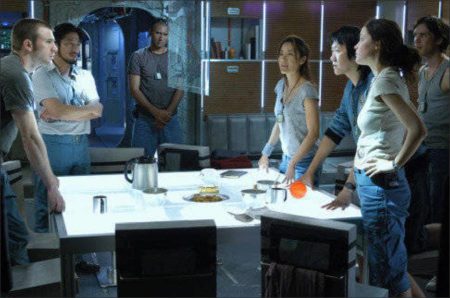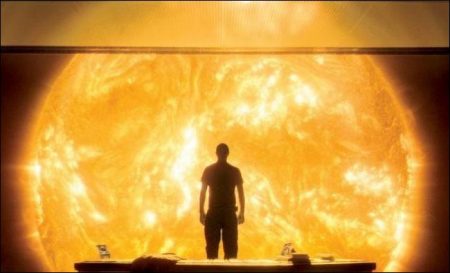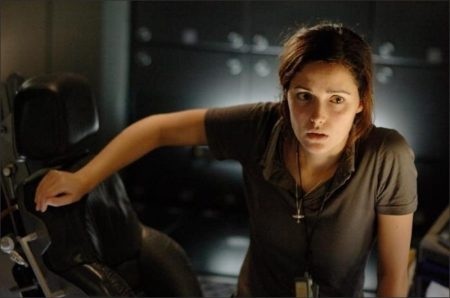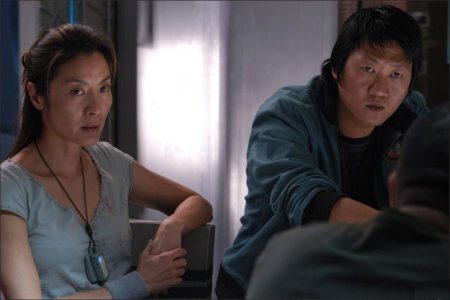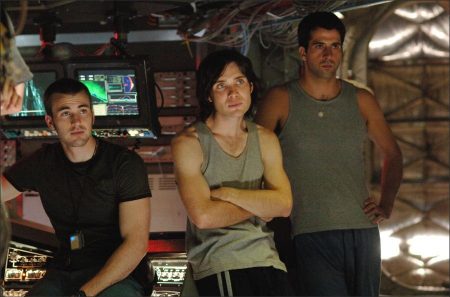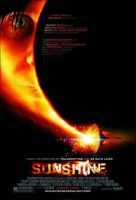If the Sun Dies: The Origins of Sunshine
With a mix of far-reaching imagination and technical virtuosity, director Danny Boyle ventures into unexplored realms of outer space with Sunshine — an intense, claustrophobic adventure about a crew of scientists and astronauts who literally are humanity’s last stand for survival, even as their mission to save the Sun, and their sanity itself, starts to fall apart under the massive stress.
The project began with a singularly compelling concept. “The premise of SUNSHINE is that in 50 years from now the Sun is dying,” explains producer Andrew Macdonald, whose recent string of provocative features includes the Oscar-winning The Last King of Scotland, Notes on a Scandal and the recent sequel, 28 Weeks Later. “The entire global community pools its resources to send a mission into space to deliver a bomb to reignite the part of the Sun that is failing. Our story concerns the eight astronauts and scientists who lead this mission — and how they react under the enormous pressure of their endeavor to save mankind.”
The idea was born in the agile imagination of writer Alex Garland, the leading British novelist who made waves with his debut book The Beach and has gone on to write the multilayered crime story The Tesseract and an intrigue-filled exploration of consciousness, The Coma, as well as the screenplay for the acclaimed sci-fi thriller 28 Days Later, in which zombies take over modern-day London. It was while reading an article in an American science magazine, that inspiration struck.
“I’ve always had a desire to explore this idea of a man traveling into deep space and what he discovers there, as well as what he finds in his own subconscious,” says Garland. “I had been looking for a storyline to hang this idea on when I read an article projecting the future of mankind from a physics-based perspective. It contained theories on when the Sun would die and what would actually happen when it eventually did. What I found interesting about that was that it is easy to speculate about the potential end of mankind billions of years from now — but what if it was a certainty within our lifetime? I was intrigued by the idea that it could get to a point where the entire planet’s survival might rest on the shoulders of one man, and by the question of what that would do to his head. That became the trigger point for the story.”
Eight months later Garland arranged to meet director Danny Boyle — who had directed the screen adaptation of his novel The Beach and for whom Garland had previously written the smash hit 28 Days Later — in a West End pub and gave him the first draft of SUNSHINE. Within 24 hours, Boyle called Garland wanting to make the film.
“What I love about Alex’s work is he has these big ideas,” explains Boyle. “The British film industry tends to make quite small films, but Alex’s writing always contains these massive ideas and concepts, which is wonderful, though they can be complex to finalize and realize.”
Boyle has already forged a reputation for daring eclecticism, having traversed from the irreverent and influential cult film Trainspotting to the family fable Millions to a harrowing, through-provoking reinvention of the zombie film with 28 Days Later. With Sunshine, Boyle was drawn in not only by the chance to envision a futuristic space voyage but especially to explore the crew’s psychological journey as they head out across the cosmos, towards the literal center of our lives, the Sun.
“Traveling to the Sun is a great concept visually, but also very interesting psychologically,” Boyle muses. “There is the question about what happens to your mind when you meet the creator of all things in the universe, which for some people is a spiritual, religious idea, and for other people is a purely scientific idea. We are all made up of particles of exploded star, so what would it be like to get close to the Sun, the star from which all the life in our solar system comes from? I thought it would be a huge mental challenge to try and capture that.”
Boyle in turn handed the script over to producer Andrew Macdonald, who found himself furiously turning the pages. “Alex writes in a tremendously visual style, and, unlike a lot of scripts you read, SUNSHINE has got a driving narrative that really pulls you along,” he says.
Macdonald was instantly sold on the concept. He was also eager to reunite with Boyle and Garland after their bracingly creative collaboration on 28 Days Later. “We share a love of certain types of films, but we all have our own opinions of how they should play out, which I think makes the relationship even stronger,” observes Macdonald. “One of the key things is that Alex is very much the writer and Danny is very much the director and they both have very strong voices. My job is to help them realize what is in their imaginations, while at the same time balancing that with the practical realities of making a successful film.”
Boyle agrees that the trio has hit upon an unusually symbiotic filmmaking process. “I think we are all very ambitious people but for some reason when we get together we abandon our egos,” the director comments. “I kick into the script and Alex kicks into the film and we are quite blunt and honest with each other and that helps the storytelling enormously.”
From the start, a key idea that all three agreed upon was to ground the film in as much science fact, rather than science fiction, as possible. Their distinctive ambition was to present on screen a starkly believable space mission of the near future, rather than a piece of pure fantasy. To accomplish this, the filmmakers looked first to NASA in their research. They also watched numerous space documentaries and met with as many scientists and astronauts as possible.
After seeing the young British physicist Dr. Brian Cox on television, Macdonald contacted him with a view to discussing the project. Thereafter Cox, who works at CERN [the Centre for European Nuclear Research], the world’s largest particle physics laboratory in Geneva, joined the production as scientific consultant, and his input was to prove invaluable. He remained on hand during production to give the cast and crew a better understanding of the Solar system, and also worked intensively with Cillian Murphy, who plays Capa, the ship’s physicist. Cox’s goal throughout was to keep the science as authentic as possible within the bounds of an imaginative thriller.
“The science is extremely sound in the film,” explains Cox. “You can tell Alex Garland is a fan of science as well as a science fiction fan. There were a few edges we ironed out but basically it was the back story rather than the plot that my expertise was needed for.” Next, to get a visceral sense of what human beings trapped in extremely tight, austere spaces for long periods of time go through psychologically, the filmmakers of SUNSHINE journeyed to Scotland to visit the closest approximation to a cramped spaceship carrying a massive bomb: a nuclear submarine.
In addition, Macdonald flew to Moscow to visit Zvezdny Gorodov, or “Star City”, the once highly secret Soviet training complex that instructs more cosmonauts and astronauts than anywhere else in the world. “It was an amazing place to visit,” he recalls. “In fact, in the early stages, we even considered shooting the film right there. But in the end it just was not viable.”
In the Shadow of the Sun: Preparing for the Film
Once the filmmakers lined up the cast of Sunshine, the actors were put through their paces, each asked to immerse themselves in their characters’ specific fields of expertise. Thus it was that Cillian Murphy, preparing to play Capa, accompanied physicist Brian Cox to his work place at CERN in Geneva, with Murphy noting: “He’s very nice man who put up with all my idiotic questions!” Meanwhile, Michelle Yeoh, in search of biological knowledge, spent time at the Eden Project in Cornwall, the world’s largest conservatory, where more than 5,000 species of plants from around the world are studied. At the same time, to better understand the ship’s engineer, Mace, Chris Evans met with NASA astronaut Daniel W. Bursch in the U.S. before joining the production in England.
To further inspire the cast, Danny Boyle screened for them a variety films including the fact-based story of NASA’s first space launch, THE RIGHT STUFF; the definitive Apollo missions documentary For All Mankind; the heart-stopping submarine classic, Das Boot; the relentless 1953 thriller Wages of Fear, about men transporting deadly nitroglycerine through the jungle; and the mind-blowing sci-fi films Alien and 2001: A Space Odyssey.
As rehearsals got under way, the process involved far more than the usual linereadings and expanded to include scuba-diving lessons, lectures by specialists in Astronomy and Physics, stunt training, flight simulation and, most nerve-wrackingly, a trip in a light aircraft to experience zero gravity.
Cillian Murphy describes the Zero-G experience as being “quite interesting, sickening, horrifying, and exhilarating all in the same time”. Adds Michelle Yeoh, “That moment of zero gravity is quite phenomenal, it takes your breath away. But when you experience several Gs… it’s not nice. Your head hurts, your chest hurts, and it feels like the whole world is sitting on you. It sounds horrifying but it is still exhilarating, and after a few moments of sheer terror you get used to it.”
Lastly, Boyle insisted his cast all live together for two weeks to build up that intense kind of familiarity only intimate living can create among a group, which is so key to the film’s riveting psychological tension. “In the film, we join the crew when they have been living together on the space ship for 16 months, so one of the key things for us was to get the cast to bond as quickly as possible and to break down any barriers,” Boyle explains.
All eight Icarus II crewmembers crammed into sparse student dormitories in the East End of London. “I thought we were going to go and live in a big house together and cook meals and have a great time,” recalls Cliff Curtis. “But no, we got put in student accommodation where we had a cell-like room with a single bed, our own shower and toilet, and a very basic kind of kitchen.”
Yet the experience was invaluable. “There’s a certain kind of chemistry that you can’t act,” explains Murphy, “It’s just in the room, in the chemistry between people, that familiarity or irritability or whatever it may be.”
This early bonding experiment became emblematic of Boyle’s approach to all of SUNSHINE – upping the realism in the visuals, design and characters to make the story’s extraordinary circumstances that much more provocative, harrowing and intense.
Sums up Chris Evans: “There was so much research done for this film. Everyone involved really got our hands dirty to understand what these characters are going through and what the movie is about. Because of that, it was a wonderful, unforgettable experience.”
Sunshine (2007)
Directed by: Danny Boyle
Starring: Rose Byrne, Cliff Curtis, Chris Evans, Troy Garity, Cillian Murphy, Hiroyuki Sanada, Benedict Wong, Michelle Yeoh, Benedict Wong, Mark Strong, Paloma Baeza, Sylvie Macdonald
Screenplay by: Alex Garland
Production Design by; Mark Tildesley
Cinematography by; Alwin H. Küchler
Film Editing by: Chris Gill
Costume Design by: Suttirat Anne Larlarb
Set Decoration by: Michelle Day
Art Direction by: Gary Freeman, Stephen Morahan, Denis Schnegg, David Warren
MPAA Rating: R for violent content and language.
Distributed by: Fox Searchlight Pictures
Release Date: September 14, 2007
Visits: 204
